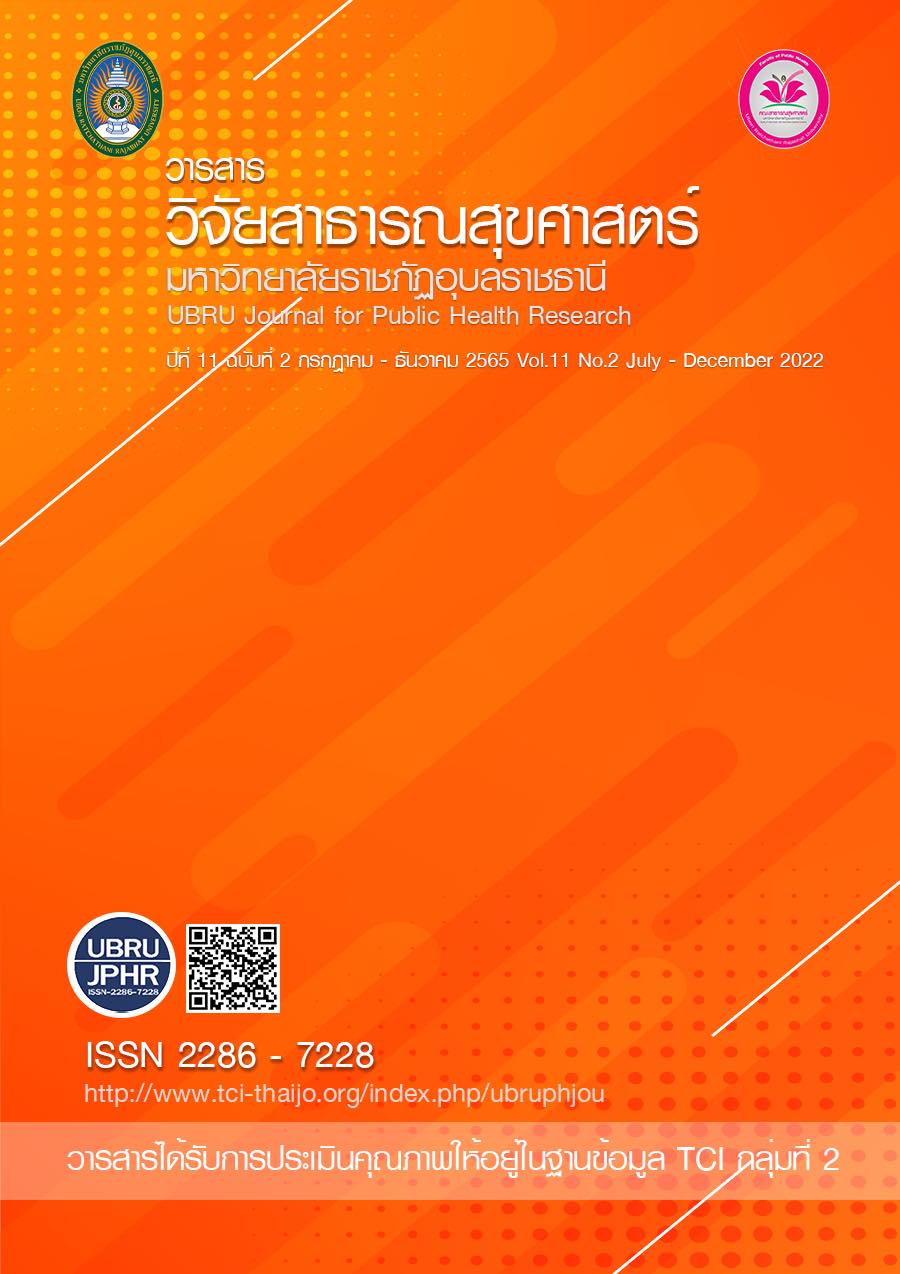The development of Tambon of Quality of life Management Model by participation of Sompoi Community, Rasi Salai District, Si Sa Ket Province
Abstract
The action research was employed for development of a sub-district model for quality of life management by applying the concept of T-PAR in organizing the development process and by applying the principles of Buddhist planning according to the four noble truths (Dukkha, Samudaya, Nirodha, Magga). The research purposes to investigate the situation, context, process of model development for improving the quality of life management by participation of Som Poi Community, Rasi Salai District, Sisaket Province. A sample group of 40 people consisting of 35 community organizations, 2 government organizations, and 3 local organizations. The data was collected by the questionnaire including; 1) the knowledge of sub-district management operation the quality of life management, 2) the attitudes of the operation of the quality of life management, 3) the assessment form for participation in the implementation of the sub-district management of quality of life. The participant observation form was also employed for group discussion. The quantitative data were analysed using descriptive statistics and the qualitative data used content analysis.
The results revealed that the participations were consisted of 6 steps: 1) the study of the community context and collecting general data, 2) Workshop, 3) Forming a participatory action plan, 4) Implementing the plan, 5) Monitoring and evaluation and 6) Summarize results and propose ways to improve quality of life. Applying a model of participatory community planning by applying Buddhist principles cause activity for the new model to manage the quality of life 2 projects and 4 activities; First project, the knowledge development for patients and risk groups for diabetes and hypertension, such as, A) Knowledge development training activities for people with diabetes and high blood pressure, B) Training activities to develop knowledge for people at risk of diabetes and high blood pressure. Second project was the community outreach project to exercise in every village, such as A) Activities exercise for the leaders, B) Exercise activities for the people.
It was also found that after the development of the model. The participants had from low level of knowledge 45.14% mean 5.65 (SD=2.98), 98.86% had high level knowledge, 8.83 mean (SD=0.40). 74.29 percent of the sub-district managed the quality of life from a moderate level of 2.77 (SD = 0.47) to a good level, 58.29 percent, an average of 3.73 (SD = 0.31), and participation in the implementation of the sub-district quality of life management was at a high level. 100% with a mean score of 4.41 (SD=0.10). The success factor is the truly participatory learning and planning of the collective community. Participate in action and make decisions Giving everyone a sense of ownership over problems and decisions. Suggestions for next study, there should be a study and promotion of participatory operations in various groups in the community in order to gain perspectives different concept in joint development including to follow-up periodically evaluate the results after the operation to ensure sustainability of the operation.
References
จีรวรรณ หัสโรค์. (2551). ประชาคมสุขภาพ กรณีศึกษาตำบลดอนหว่าน อำเภอเมือง จังหวัดมหาสารคาม. พิมพ์ครั้งที่ 3. กรุงเทพฯ:
บพิธการพิมพ์.
ณัฐดนัย แก้วโพนงาม. (2562). การส่งเสริมคุณภาพชีวิตประชาชนและผู้สูงอายุบ้านนาฝาย ตำบลนาฝาย อำเภอเมืองชัยภูมิ จังหวัดชัยภูมิ. วารสารวิทยาลัยสงฆ์นครลำปาง. 8(1),33-41
ประสพ สารสมัคร. (2557). การจัดการความรู้และการพัฒนาการดำเนินงานตำบลจัดการสุขภาพดีวิถีไทยโดยการมีส่วนร่วมของชุมชน ตำบลบ้านแดง อำเภอตระการพืชผล จังหวัดอุบลราชธานี. วิทยานิพนธ์ปริญญาสาธารณสุขศาสตร
มหาบัณฑิต สาขาวิชาสาธารณสุขศาสตร์ คณะสาธารณสุขศาสตร์ มหาวิทยาลัยมหาสารคาม.
รัตนาภรณ์ เฉลิมศรี. (2561). การพัฒนารูปแบบการป้องกันโรคขาดสารไอโอดีนของหญิงวัยเจริญพันธุ์โดยการมีส่วนร่วมของชุมชน เชิงพุทธตำบลนาโพธิ์ อำเภอกุดรัง จังหวัดมหาสารคาม. วิทยานิพนธ์ปริญญาสาธารณสุขศาสตรมหาบัณฑิตสาขาวิชาสาธารณสุขศาสตร์ คณะสาธารณสุขศาสตร์ มหาวิทยาลัยมหาสารคาม.
รัชนีวิภา จิตรากุลและคณะ.(2559). การพัฒนารูปแบบหมู่บ้านจัดการสุขภาพโดยการมีส่วนร่วมของชุมชนจังหวัดมหาสารคาม. วารสารช่อพะยอม. 26(2).195-208.
โรงพยาบาลส่งเสริมสุขภาพตำบลส้มป่อย. (2562). สรุปผลการดำเนินงานตำบลส้มป่อย ปี 2562. ศรีสะเกษ: โรงพยาบาลส่งเสริมสุขภาพตำบลส้มป่อย.
วารุณี เปรมสิงห์. (2562).การพัฒนารูปแบบการดำเนินงานตำบลจัดการสุขภาพโดยการมีส่วนร่วมของชุมชน.ตำบลหนองแหวง อำเภอนิคมคำสร้อย จังหวัดมุกดาหาร. วารสารวิจัยสาธารณสุขศาสตร์ มหาวิทยาลัยราชภัฏอุบลราชธานี. 8(2),6-12.
สำนักงานสาธารณสุขจังหวัดศรีสะเกษ. (2562). นโยบายเกี่ยวกับการดำเนินงานตำบลจัดการคุณภาพชีวิตมาตั้งแต่ปี พ.ศ. 2562 จนถึงปัจจุบัน. ศรีสะเกษ: สำนักงานสาธารณสุขจังหวัดศรีสะเกษ.
Downloads
Published
How to Cite
Issue
Section
License
Copyright (c) 2022 คณะสาธารณสุขศาสตร์ มหาวิทยาลัยราชภัฏอุบลราชธานี

This work is licensed under a Creative Commons Attribution-NonCommercial-NoDerivatives 4.0 International License.
เนื้อหาและข้อมูลในบทความที่ลงตีพิมพ์ในวารสารวารสารวิจัยสาธารณสุขศาสตร์ มหาวิทยาลัยราชภัฏอุบลราชธานี ถือเป็นข้อคิดเห็นและความรับผิดชอบของผู้เขียนบทความโดยตรงซึ่งกองบรรณาธิการวารสาร ไม่จำเป็นต้องเห็นด้วย หรือร่วมรับผิดชอบใดๆ
บทความ ข้อมูล เนื้อหา รูปภาพ ฯลฯ ที่ได้รับการตีพิมพ์ในวารสารนี้ ถือเป็นลิขสิทธิ์ของวารสารฯ หากบุคคลหรือหน่วยงานใดต้องการนำทั้งหมดหรือส่วนหนึ่งส่วนใดไปเผยแพร่ต่อหรือเพื่อกระทำการใดๆ จะต้องได้รับอนุญาตเป็นลายลักอักษรณ์จากบรรณาธิการวารสารนี้ก่อนเท่านั้น


